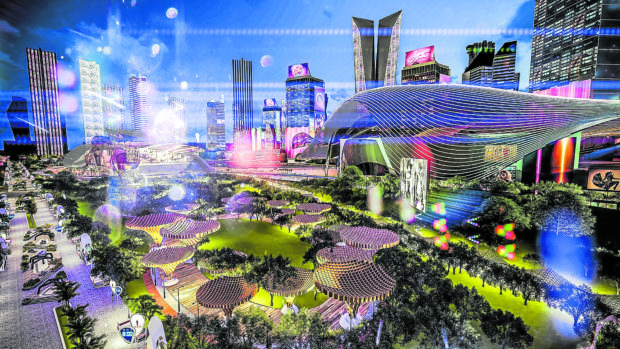
Central business districts may have always been known as the “heart of the city,” but with global populations growing at a rapid pace, how many “hearts” will a city need to truly unlock its full potential?
Human ecology vs land economics
Organically growing cities may have evolved from a “survival of the fittest” principle driven by competition for resources as well as symbiosis through the division of labor. However, there exists another theory in land economics wherein land use patterns are pre-determined depending on who can affor
d the central area of dominance, also known as the primary CBD located at the heart of every city.
As the urban population grows exponentially, it is no surprise that from a single CBD, the occurrence of a second, or even third CBD is becoming commonplace.
CBDs, then and now
There’s quite a confusion surrounding CBDs, as the term may stand for two different phrases—commercial business districts or central business districts. However, both are used interchangeably due to the common phenomenon of having the highest concentrations of businesses and office employment in developed countries. This makes the CBD the “heart of the city,” which jumpstarts the growth not only of its urban core, but also the other parts of the city and its surrounding localities.
Despite the diversity of today’s CBDs in terms of architecture, network and overall growth, there appears to be three common denominators among these communities. These include a central commercial area, surrounding industrial zones and several residential areas which may or may not be deliberately differentiated into social classes.
Impact of e-commerce
It’s no secret that consumer trends and habits are changing in response to the pandemic. Sure enough, there arises a need to change the way we perceive shopping and retail, especially within CBDs where these industries mainly thrive.
According to investment advisors Forsyth Barr, the rise of e-commerce led retailers to settle into smaller stores that offer a unique shopping experience akin to spending a day at the beach or just any other tourist destination at that. On that note, purchases will no longer be heavily founded on necessity. Instead, they will be a result of leisure and recreation.
Maintaining diversity, global competitiveness
Although CBDs are often dense, globally connected spaces that serve as the center point for local and international transactions, it is undeniable that most CBDs are imbalanced and lean towards corporate, commercial and economic functions. The huge gaps between transient weekday and weekend populations became evident during the pandemic, and what used to be the core strength of CBDs became their Achilles’ heel.
To support a growing economy, CBDs should maintain a diverse mix of business and leisure districts, along with improved transit and pedestrian access inside and outside the CBD core, eventually expanding to the outskirts. Welcoming establishments with a greater mix of uses that focus on experience, destination, as well as the evolving work patterns and mobility becomes the obvious solution.
For example, the Alabang CBD takes a break from the skyline of high-rise buildings typical of other business hubs in Metro Manila. This, along with a mix of leisure and business establishments, make Alabang CBD an ideal place for more efficient, modest structures.
Employment as driving force of CBDs
There is no doubt that no matter how urbanized a CBD is, it won’t be as successful without productive manpower working behind the scenes. This is why a successful CBD should not only be about attracting high value businesses, but also high value jobs. Having a thriving employment sector within a CBD will not only benefit the core alone, but will also ignite continuous cash flow that extends to localities outside the CBD, indirectly supporting jobs ranging from retail to technology.
Importance of transit connectivity
It is natural for businesses to want their employees to be closer to their workplaces, or for employees to want to live near their offices. However, the location and economic capability of the cities where the CBDs are located may cause some conditions to be unmet.
This is where the importance of transit connectivity can be highlighted. The efficiency of public transportation cannot be measured with the hypothetical absence of traffic congestion and abundant parking spaces. An efficient public transportation network means a seamless commute that connects multiple modes of transportation into a single transportation hub.
Take the case of Ortigas Center, dubbed as the “Shopping Capital of the Philippines,” where Mandaluyong, Pasig and Quezon City all gather into a single hub. Its easy city-to-city access—through multiple transport options ranging from buses to rail systems—allows residents and visitors to enjoy the CBD’s promotion of a good work-life balance manifested through a wide variety of leisure establishments like parks and shopping malls.
CBDs, now and the future
As urbanization takes global economies by storm, there’s a newfound emphasis on meeting the needs and demands of the people which redefined today’s CBDs as central business districts that slowly transitioned from an exclusive space for doing business to a mutually inclusive space driven by public feedback and critical anticipation of the future.
The author is the principal architect of Fulgar Architects, an architectural firm with unique and diversified planning and design specialties for local and international property developers into real estate investments, hospitality, condominiums, commercial and mixed-use township developments. Visit Fulgararchitects.com
Article and Photo originally posted by Inquirer last June 7, 2021 12:09am and written by Ar. John Ian Lee Fulgar.








More Stories
Vista Land Celebrates Love Month in Ilocos Region
Vista Land Bridges Cebuano Heritage and Progress with Valencia by Vista Estates
Real Estate 2024 and Beyond: A day of learning, innovation, and inspiration!